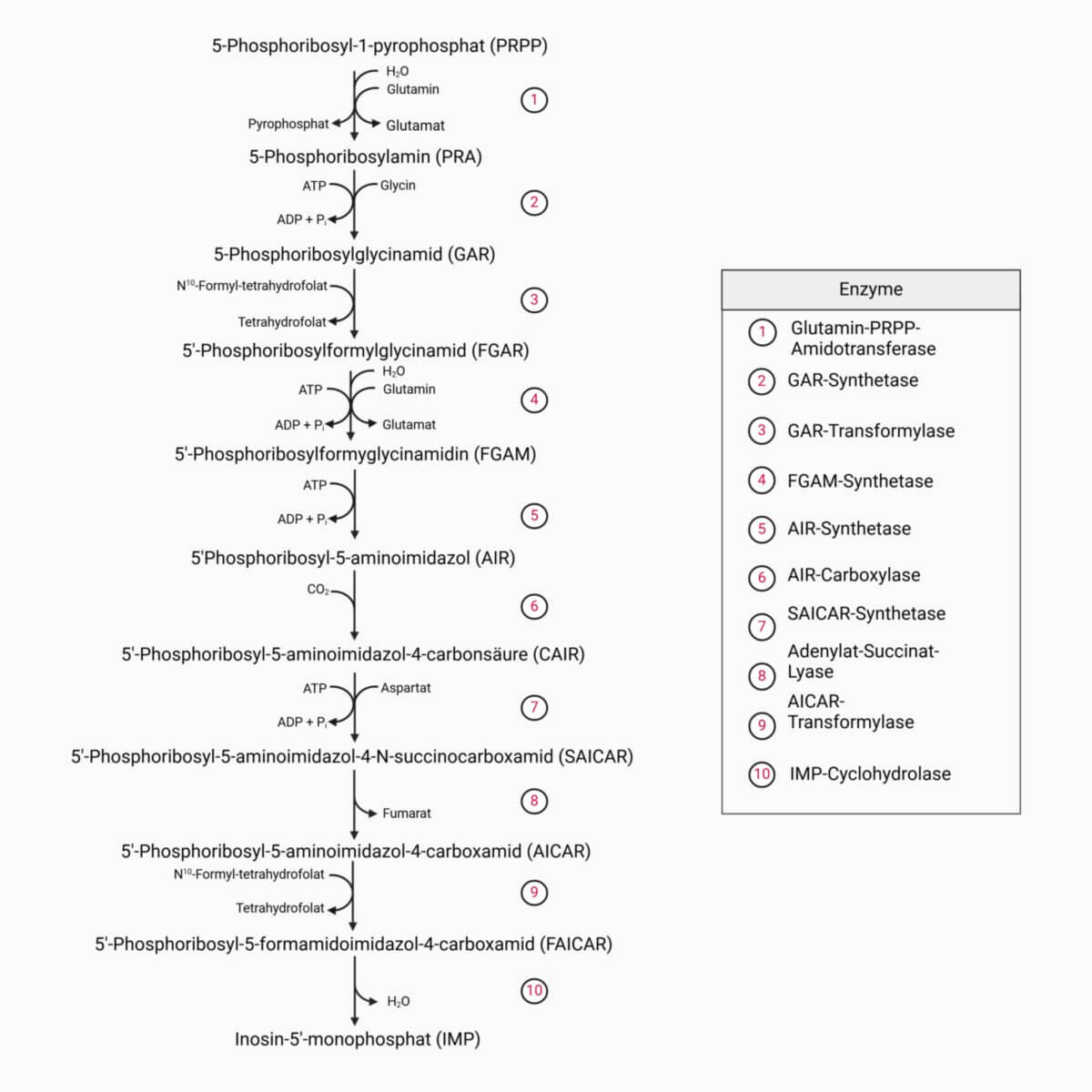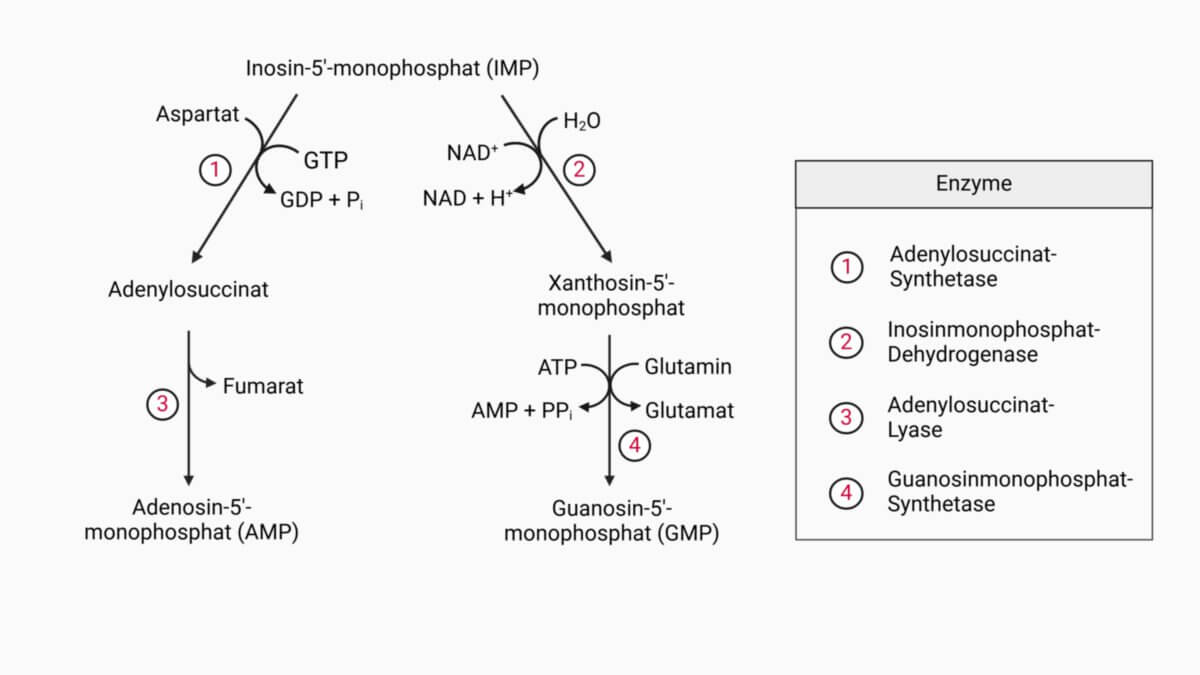Purinbiosynthese: Unterschied zwischen den Versionen
Keine Bearbeitungszusammenfassung |
(Abbildung "Biosynthese von AMP und GMP aus IMP" hinzugefügt) |
||
| (6 dazwischenliegende Versionen von 4 Benutzern werden nicht angezeigt) | |||
| Zeile 1: | Zeile 1: | ||
''Synonyme: IMP-de novo-Synthese, Purinringsynthese''<br> | ''Synonyme: IMP-de novo-Synthese, Purinringsynthese''<br> | ||
'''''Englisch:''' purine biosynthesis'' | '''''Englisch:''' <name lang="en">purine biosynthesis</name>'' | ||
==Definition== | ==Definition== | ||
| Zeile 21: | Zeile 21: | ||
#5'-Phosphoribosyl-5-aminoimidazol-4-N-succinocarboxamid (SAICAR) → 5'-Phosphoribosyl-5-aminoimidazol-4-carboxamid ([[AICAR]])<br>Enzym: [[Adenylat-Succinat-Lyase]] ([[Fumarat]] geht) | #5'-Phosphoribosyl-5-aminoimidazol-4-N-succinocarboxamid (SAICAR) → 5'-Phosphoribosyl-5-aminoimidazol-4-carboxamid ([[AICAR]])<br>Enzym: [[Adenylat-Succinat-Lyase]] ([[Fumarat]] geht) | ||
#5'-Phosphoribosyl-5-aminoimidazol-4-carboxamid (AICAR) → 5'Phosphoribosyl-5-formamidoimidazol-4-carboxamid ([[FAICAR]])<br>Enzym: [[AICAR-Transformylase]] (N<sup>10</sup>-Formyl-THF kommt, THF geht) | #5'-Phosphoribosyl-5-aminoimidazol-4-carboxamid (AICAR) → 5'Phosphoribosyl-5-formamidoimidazol-4-carboxamid ([[FAICAR]])<br>Enzym: [[AICAR-Transformylase]] (N<sup>10</sup>-Formyl-THF kommt, THF geht) | ||
#5'-Phosphoribosyl-5-formamidoimidazol-4-carboxamid (FAICAR) → Inosin-5'-monophosphat (IMP)<br>Enzym: [[IMP-Cyclohydrolase]] (H<sub>2</sub>O geht) | #5'-Phosphoribosyl-5-formamidoimidazol-4-carboxamid (FAICAR) → Inosin-5'-monophosphat (IMP)<br>Enzym: [[IMP-Cyclohydrolase]] (H<sub>2</sub>O geht)<dcembed ratio="1x1"><dcEmbedUrl src="https://www.doccheck.com/de/detail/photos/43778-purinbiosynthese"></dcEmbedUrl></dcembed> | ||
An das IMP anschließend, verzweigt sich der Syntheseweg in zwei Richtungen: Einerseits in Richtung [[AMP]], andererseits in Richtung [[GMP]]. Als abschließende Reaktion müssen die [[Monophosphat]]e noch zu [[Diphosphat|Di-]] und [[Triphosphat]]en [[Phosphorylierung|phosphoryliert]] werden. | An das IMP anschließend, verzweigt sich der Syntheseweg in zwei Richtungen: Einerseits in Richtung [[Adenosinmonophosphat|AMP]], andererseits in Richtung [[GMP]]. Als abschließende Reaktion müssen die [[Monophosphat]]e noch zu [[Diphosphat|Di-]] und [[Triphosphat]]en [[Phosphorylierung|phosphoryliert]] werden.<dcembed ratio="16x9"><dcEmbedUrl src="https://www.doccheck.com/de/detail/photos/43832-biosynthese-von-amp-und-gmp-aus-imp"></dcEmbedUrl></dcembed> | ||
==Literatur== | ==Literatur== | ||
| Zeile 32: | Zeile 32: | ||
[[Tag:Stoffwechsel]] | [[Tag:Stoffwechsel]] | ||
[[Tag:Synthese]] | [[Tag:Synthese]] | ||
[[Kategorie:Stoffwechselweg]] | |||
Aktuelle Version vom 21. Januar 2025, 12:53 Uhr
Synonyme: IMP-de novo-Synthese, Purinringsynthese
Englisch: purine biosynthesis
Definition
Die Purinbiosynthese ist ein Stoffwechselweg, der die Biosynthese des Purinringsystems ermöglicht.
Hintergrund
Purine sind ein wesentlicher Bestandteil der DNA. Sie dienen als Energieträger (ATP) und bilden die Basis für die Synthese wichtiger Stoffe. Im Organismus werden sie nicht als freie Moleküle, sondern als Nukleotide synthetisiert.
Ausgangsprodukt der Purinsynthese ist das α-D-Ribose-5-phosphat (Zwischenprodukt des Pentosephosphatzyklus), das nach einer Aktivierung zu 5-Phosphoribosyl-α-pyrophosphat (PRPP) und zehn weiteren Schritten als Inosin-5'-monophosphat (IMP) endet. Dieses kann in weiteren Schritten zu den Nukleotiden des Xanthinosins, Adenosins oder Guanosins umgebaut werden.
Einzelschritte
Das Grundgerüst des Purins wird in elf Einzelschritten aufgebaut. Verschiedene Moleküle liefern die dazu notwendigen Bestandteile. Der 0. Schritt ist die Aktivierung des α-D-Ribose-5-phosphat zu PRPP. Die folgenden zehn Schritte sind:
- 5-Phosphoribosyl-1-pyrophosphat (PRPP) → 5-Phosphoribosylamin (PRA)
Enzym: Glutamin-PRPP-Amidotransferase (Glutamin kommt,
Glutamat u. PPi gehen) - 5-Phosphoribosylamin (PRA) → 5-Phosphoribosylglycinamid (GAR)
Enzym: GAR-Synthetase (Glycin u. ATP kommen, ADP + Pi gehen) - 5-Phosphoribosylglycinamid (GAR) → 5'-Phosphoribosylformylglycinamid (FGAR)
Enzym: GAR-Transformylase (N10-Formyl-THF kommt, THF geht) - 5'-Phosphoribosylformylglycinamid (FGAR) → 5'-Phosphoribosylformyglycinamidin (FGAM)
Enzym: FGAM-Synthetase (Glutamin u. ATP kommen, Glutamat u.
ADP + Pi gehen) - 5'-Phosphoribosylformyglycinamidin (FGAM) → 5'Phosphoribosyl-5-aminoimidazol (AIR)
Enzym: AIR-Synthetase (ATP kommt, ADP + Pi gehen) - 5'Phosphoribosyl-5-aminoimidazol (AIR) → 5'-Phosphoribosyl-5-aminoimidazol-4-carbonsäure (CAIR)
Enzym: AIR-Carboxylase (CO2 kommt) - 5'-Phosphoribosyl-5-aminoimidazol-4-carbonsäure (CAIR) → 5'-Phosphoribosyl-5-aminoimidazol-4-N-succinocarboxamid (SAICAR)
Enzym: SAICAR-Synthetase (Aspartat u. ATP kommen,
ADP + Pi gehen) - 5'-Phosphoribosyl-5-aminoimidazol-4-N-succinocarboxamid (SAICAR) → 5'-Phosphoribosyl-5-aminoimidazol-4-carboxamid (AICAR)
Enzym: Adenylat-Succinat-Lyase (Fumarat geht) - 5'-Phosphoribosyl-5-aminoimidazol-4-carboxamid (AICAR) → 5'Phosphoribosyl-5-formamidoimidazol-4-carboxamid (FAICAR)
Enzym: AICAR-Transformylase (N10-Formyl-THF kommt, THF geht) - 5'-Phosphoribosyl-5-formamidoimidazol-4-carboxamid (FAICAR) → Inosin-5'-monophosphat (IMP)
Enzym: IMP-Cyclohydrolase (H2O geht)
An das IMP anschließend, verzweigt sich der Syntheseweg in zwei Richtungen: Einerseits in Richtung AMP, andererseits in Richtung GMP. Als abschließende Reaktion müssen die Monophosphate noch zu Di- und Triphosphaten phosphoryliert werden.
Literatur
- "Duale Reihe Biochemie" - Joachim Rassow et. al., Thieme-Verlag, 3. Auflage


